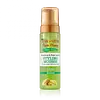What's inside
What's inside
 Benefits
Benefits

 Concerns
Concerns

 Ingredients Side-by-side
Ingredients Side-by-side

Water
Skin ConditioningPEG-40 Hydrogenated Castor Oil
EmulsifyingPolyquaternium-11
Persea Gratissima Oil
Skin ConditioningMel
EmollientCocos Nucifera Oil
MaskingButyrospermum Parkii Butter
Skin ConditioningCaprylyl Glycol
EmollientCocamidopropyl Betaine
CleansingPanthenol
Skin ConditioningPEG-40 Lanolin
EmulsifyingBenzophenone-4
UV AbsorberParfum
MaskingAlpha-Isomethyl Ionone
PerfumingBenzyl Salicylate
PerfumingHydroxycitronellal
PerfumingLimonene
PerfumingLinalool
PerfumingPhenoxyethanol
PreservativeCI 42090
Cosmetic ColorantCI 19140
Cosmetic ColorantWater, PEG-40 Hydrogenated Castor Oil, Polyquaternium-11, Persea Gratissima Oil, Mel, Cocos Nucifera Oil, Butyrospermum Parkii Butter, Caprylyl Glycol, Cocamidopropyl Betaine, Panthenol, PEG-40 Lanolin, Benzophenone-4, Parfum, Alpha-Isomethyl Ionone, Benzyl Salicylate, Hydroxycitronellal, Limonene, Linalool, Phenoxyethanol, CI 42090, CI 19140
Water
Skin ConditioningIsobutane
Hydrofluorocarbon 152a
Vp/Va Copolymer
Hydrolyzed Elastin
EmollientPropane
Polyquaternium-11
Polysorbate 20
EmulsifyingPvp
Emulsion StabilisingPolyquaternium-4
Parfum
MaskingPPG-12-PEG-50 Lanolin
EmulsifyingOlealkonium Chloride
Polyquaternium-7
Sodium Benzoate
MaskingPropylene Glycol
HumectantCyclopentasiloxane
EmollientGlycerin
HumectantSorbitol
HumectantCocamidopropyl Betaine
CleansingCyclohexasiloxane
EmollientAmyl Cinnamal
PerfumingBenzyl Alcohol
PerfumingBenzyl Benzoate
AntimicrobialCitronellol
PerfumingGeraniol
PerfumingHexyl Cinnamal
PerfumingHydroxycitronellal
PerfumingLimonene
PerfumingLinalool
PerfumingWater, Isobutane, Hydrofluorocarbon 152a, Vp/Va Copolymer, Hydrolyzed Elastin, Propane, Polyquaternium-11, Polysorbate 20, Pvp, Polyquaternium-4, Parfum, PPG-12-PEG-50 Lanolin, Olealkonium Chloride, Polyquaternium-7, Sodium Benzoate, Propylene Glycol, Cyclopentasiloxane, Glycerin, Sorbitol, Cocamidopropyl Betaine, Cyclohexasiloxane, Amyl Cinnamal, Benzyl Alcohol, Benzyl Benzoate, Citronellol, Geraniol, Hexyl Cinnamal, Hydroxycitronellal, Limonene, Linalool
Ingredients Explained
These ingredients are found in both products.
Ingredients higher up in an ingredient list are typically present in a larger amount.
Cocamidopropyl Betaine is a fatty acid created by mixing similar compounds in coconut oil and dimethylaminopropylamine, a compound with two amino groups.
This ingredient is a surfactant and cleanser. It helps gather the dirt, pollutants, and other impurities in your skin to be washed away. It also helps thicken a product and make the texture more creamy.
Being created from coconut oil means Cocamidopropyl Betaine is hydrating for the skin.
While Cocamidopropyl Betaine was believed to be an allergen, a study from 2012 disproved this. It found two compounds in unpure Cocamidopropyl Betaine to be the irritants: aminoamide and 3-dimethylaminopropylamine. High-grade and pure Cocamidopropyl Betaine did not induce allergic reactions during this study.
Learn more about Cocamidopropyl BetaineHydroxycitronellal is a fragrance created from citronellal. The smell of hydroxycitronellal is often described as "citrus-like" or "melon-like".
Hydroxycitronellal is a known EU allergen and may cause irritation when applied to the skin.
Limonene is a fragrance that adds scent and taste to a formulation.
It's found in the peel oil of citrus fruits and other plants such as lavender and eucalyptus. The scent of limonene is generally described as "sweet citrus".
Limonene acts as an antioxidant, meaning it helps neutralize free radicals.
When exposed to air, oxidized limonene may sensitize the skin. Because of this, limonene is often avoided by people with sensitive skin.
The term 'fragrance' is not regulated in many countries. In many cases, it is up to the brand to define this term. For instance, many brands choose to label themselves as "fragrance-free" because they are not using synthetic fragrances. However, their products may still contain ingredients such as essential oils that are considered a fragrance.
Learn more about LimoneneLinalool is a fragrance and helps add scent to products. It's derived from common plants such as cinnamon, mint, citrus, and lavender.
Like Limonene, this ingredient oxidizes when exposed to air. Oxidized linalool can cause allergies and skin sensitivity.
This ingredient has a scent that is floral, spicy tropical, and citrus-like.
Learn more about LinaloolParfum is a catch-all term for an ingredient or more that is used to give a scent to products.
Also called "fragrance", this ingredient can be a blend of hundreds of chemicals or plant oils. This means every product with "fragrance" or "parfum" in the ingredients list is a different mixture.
For instance, Habanolide is a proprietary trade name for a specific aroma chemical. When used as a fragrance ingredient in cosmetics, most aroma chemicals fall under the broad labeling category of “FRAGRANCE” or “PARFUM” according to EU and US regulations.
The term 'parfum' or 'fragrance' is not regulated in many countries. In many cases, it is up to the brand to define this term.
For instance, many brands choose to label themselves as "fragrance-free" because they are not using synthetic fragrances. However, their products may still contain ingredients such as essential oils that are considered a fragrance by INCI standards.
One example is Calendula flower extract. Calendula is an essential oil that still imparts a scent or 'fragrance'.
Depending on the blend, the ingredients in the mixture can cause allergies and sensitivities on the skin. Some ingredients that are known EU allergens include linalool and citronellol.
Parfum can also be used to mask or cover an unpleasant scent.
The bottom line is: not all fragrances/parfum/ingredients are created equally. If you are worried about fragrances, we recommend taking a closer look at an ingredient. And of course, we always recommend speaking with a professional.
Learn more about ParfumWe don't have a description for Polyquaternium-11 yet.
Water. It's the most common cosmetic ingredient of all. You'll usually see it at the top of ingredient lists, meaning that it makes up the largest part of the product.
So why is it so popular? Water most often acts as a solvent - this means that it helps dissolve other ingredients into the formulation.
You'll also recognize water as that liquid we all need to stay alive. If you see this, drink a glass of water. Stay hydrated!
Learn more about Water